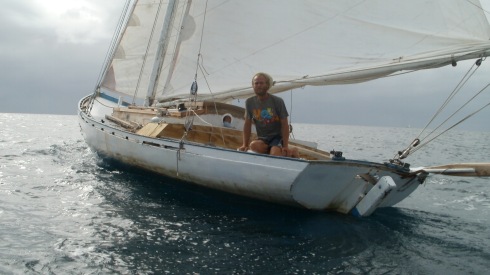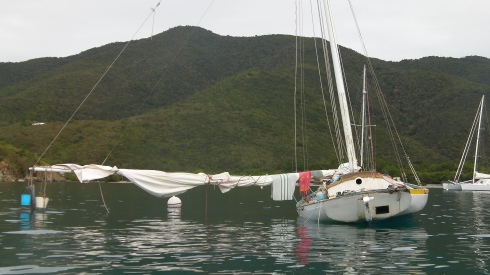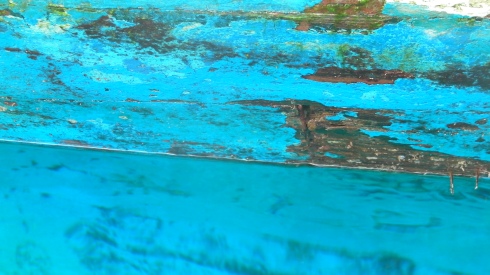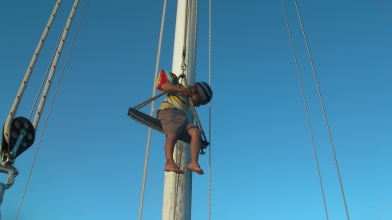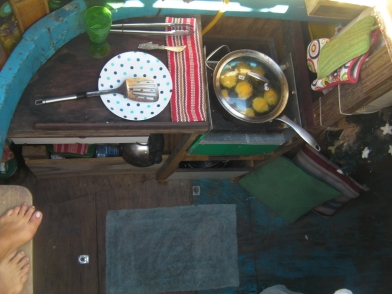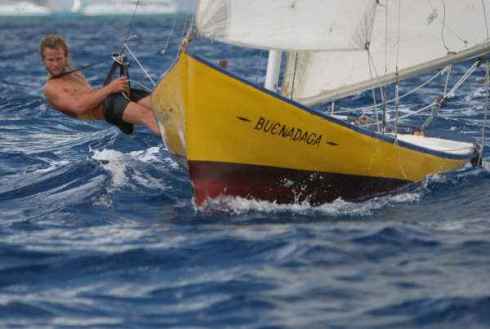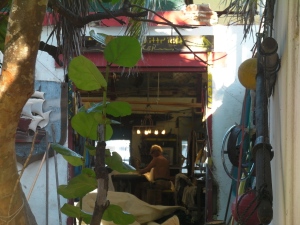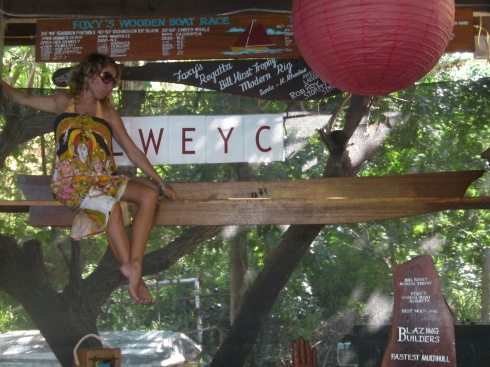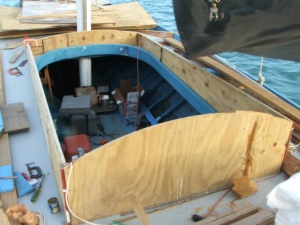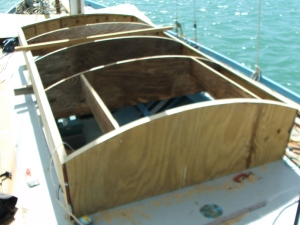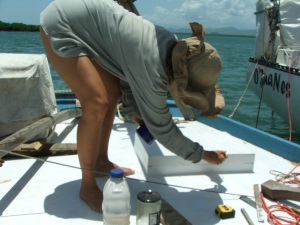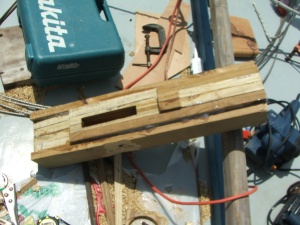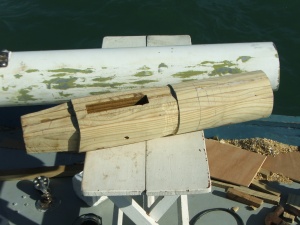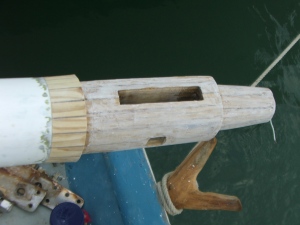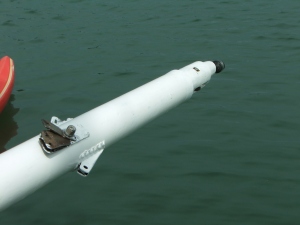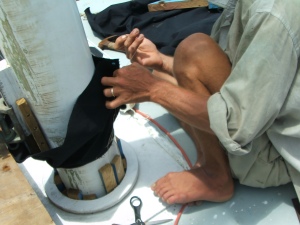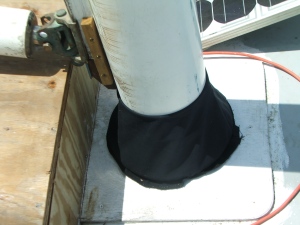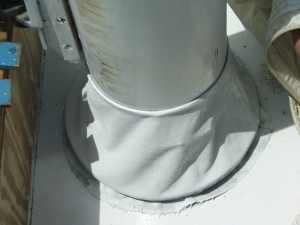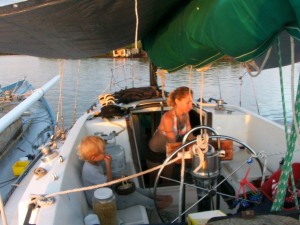You are currently browsing the tag archive for the ‘boat work’ tag.
Sailing back to St John from the BVI’s i decided to “do things the right way” and clear in. If you read the US coast guard rules carefully it is written that boats that are unable to support motorized propulsion and are under 10 M are exempt from registration. This little known fact is why almost no nativo is registered, and gets away with it. But good luck trying to educate an “officer of the law” about the law..
After alluding threateningly to the risk of having my boat confiscated, he warned me to get the paperwork in order a.s.a.p. and i shuffled out of there as quickly as possible,.. but wait ! There’s more; a uniformed lady stops me to ask if i’m aware of the rules concerning on board refuse. Foolishly i confess that i don’t to which she gives me a paper foldout and goes over the rules in pedantic detail. Turns out any garbage containing organic matter from non US countries (such as the BVI’s) is considered a bio hazard and needs to get disposed of at the special incinerator for hazardous wastes, at my expense naturally. Kitchen refuse cannot be stored on deck or there is a fine for that, such as used paper plates, she added. Paper plates? I have never and will never waste valuable treewood for such a purpose, i have proper plates that get washed and re-used for one’s whole lifetime, i was thinking, also realizing that the fact that we wash them right in the seawater was no doubt a felony as well, so i just smiled and nodded politely. In fact all our kitchen refuse which is bio degradable just goes straight overboard to feed the crabs and other marine detrivores. At sea, tin cans and glass go right over the side as well, since they turn into iron oxide and sand respectively, at no environmental harm. What i do not throw at sea is plastic, for obvious reasons. Since i detest having garbage build up on board what i do before a trip is put all the plastic packaged food sans package in big jars i have which are roach proof and all the plastic goes right back ashore to the tip. That way no problematic garbage builds up on board.
At any rate i kept my garbage philosophy to myself and with a great self restraint managed to not blurt out «so how do you manage to round up all the birds that fly across from Tortola without having checked in whilst joyously pooping the whole time, so that they can be incinerated?»
The sermon over, i was not sad to get out of that office!
Note how the dinghy sits tucked behind the coach roof; weight low down, and offering an absolute minimum of windage. Also in the most convenient position possible to just untie, flip over and slide over the rail into the water. This picture was taken just out the bay, which is why it’s still so calm.
St John is a very strange island. It is the logical conclusions of extreme gentrification. Rich people (read really really rich) have been buying up property, driving up prices to astronomical heights. Then the locals can’t afford a roof and feel marginalized, forgetting of course that they sold voluntarily. Once that gets started it escalates into a severely divided society, with tremendous amounts of tension.
The rich people create a dumpster diving paradise though. A friend there showed me an almost brand new fairly decent bicycle he found at the dump; the only thing wrong with it was a flat tyre! I might have been tempted to see what goodies i could scavenge too but had neither the time nor the desire to see a single extra thing added to the already overloaded Oasis.
Here a friendly neighbour on a catamaran gave me his storm jib, saying he had retired from sailing and so would no longer need it and i did make an exception to not wanting more stuff on board when it’s something that makes the boat safer. This proved to be an extremely valuable addition the Oasis’s set of sails, fitting perfectly and with a very flat cut, which is what you want in strong winds. At the same time, the Oasis’s other jib, the original one, which came with the boat, i had recut as a storm mainsail.
After a few days in St John getting some more things done onboard we left, just as the weather was turning for the worse, heading towards St Martin.
Now it’s certain that the Caribbean can’t compare to the wild and wooly North Sea (save for when there is a hurricane!) but that is not a reason to allow the azure skies and limpid waters lull one into thinking that it is always idyllic. In fact it can get quite brave and unpleasant at times. Naturally no pics of the best moments, not really thinking about taking pictures when things get hectic, and besides, i always worry about getting the camera wet. Suffice to say therefore that soon after leaving the wind picked up to about force six or seven and the waves quickly became lumpen and confused, the boat leaping and bucking over them, the lee rail awash as i put more reefs in the jib.
Then i discovered the Oasis was leaking a rather unacceptable amount. I pondered carrying on like this across the Anegada passage which is famous for its vicious seas or turning back to St John losing precious distance gained to windward and possibly having to re encounter the menacing customs man.. Studying the chart i saw that there was actually a little cove just north of us that we could shelter in and i could see what this leak was really about.
It proved to be a wonderfully calm anchorage with astonishingly transparent water. No motor boats, no houses, just peace and quiet.
Remarkably i was able to locate the leak very easily (this is not the usual case with a leak) and it turned out to be a deteriorated butt seam. I would just have to patch it temporarily with some epoxy putty. Since it was near the waterline and knowing from experience how hard it is to force putty into a crack underwater such that it remains stuck to the hull rather that the spatula, or neither, dropping to the seafloor, i decided to heel the boat such that the bad seam would be just free of the water.
With the 5000 kg of lead ballast, 2.2 M draft and 3.3 M of beam the Oasis is certainly quite stiff but at least the boom is long enough to give enough leverage to heel the boat over usefully. With anchors, chain and buckets of water at the end of the boom i was able to get the damaged area just out of the water.
A bit of PC11 epoxy putty took care of this leak.
My internet will be cut off any day now since i stopped paying for it, so this will be the last post for a while i think. By next post i should be in a more stable situation i hope.
I’m a fan of sailing at night, especially if it means making landfall at dawn. On long pasages, landfall at dawn is always the best; in this way one can spot the various lights and identify them on the chart to confirm and correct one’s position, and then as the sunlight fills in, safely pilot into port.
On this first leg up from Vieques to St Thomas, that is too short a distance to be anything other than piloting, but there is another advantage to sailing at night in the tropics; avoiding the relentless tropical sun!
So as we plunge into the darkness and the sun approaches the nadir the wind gets stronger and stronger. I have been progressively letting the mainsheet out as the reefpoints have yet to be made. Finally it gets to the point that the main is almost wholly luffing, the entire boat shuddering under far too much sail, so i take the mainsail down entirely and we carry on with just the jib.
It is an odd thing that on the Oasis, which has such a strongly raked keel (meaning it is much deeper aft than for’rds) and thus its center of lateral resistance very far aft still manages to point up to windward well enough under just the jib. Looking at this on a drawing board most naval architects would likely state emphatically that the boat will have tremendous lee helm, when in fact, if the wind is fresh the helm is neutral (does not have to be tied). This shows that the issue of balance is somewhat more subtle than certain boat design textbooks would have us believe.
However i do not like to proceed in this manner because it puts excessive strain on the jib and the rig, which has to rely almost entirely on the running backstays to counteract the jibstay tension, rather than have the mainsail do most of that work.
At dawn we were approaching Charlotte Amalie and the wind seemed to be easing off just a touch, although it was still very fresh, but i decided to put the mainsail back up to improve the boat’s manoeuverability for entering the crowded harbour.
So we sail in under much too much sail; in the lulls the boat creaming along, but in every tremendous gust coming crashing down the steep slopes around Charlotte Amalie harbour letting the mainsheet out and the boat quivering with the rails under, as the furiously ruffled water patch passes by. It was a bit of a relief to get the sails down and the anchor overboard at the first reasonable anchoring spot.
–*–
Charlotte Amalie and St Thomas in general, always used to be a long time favorite of mine, but the charming all pervasive “yes mon” attitude had quite quickly been replaced with a general malaise and sourness symptomatic of economic difficulties, unsurprisingly, since tourism is the first expenditure to be reduced by people undergoing financial dificulties. St Thomas has an economy that is almost entirely based on tourism and so that put it in a particularly vulnerable position after the economic crisis.
I wasted no time getting to Hassel island in Charlotte Amalie harbour to get the reef points added to my mainsail and the jib by Dietrich, who incidentally, had met my father when they were both sailing in the Caribbean in the nineteensixties. I marked where the reef points had to go and made them deep, such that by the third reef, less than half the sail remains. In the jib’s case there was also the consideration of maintaining the correct sheeting angles for each reef whilst keeping the jib sheet fairlead in the same position. Dietrich does very good work and i highly recommend using his services for any sail or canvas work you may have if you happen to be in the Virgin Islands.
—–*—–
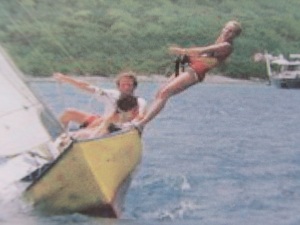
Christina hiking out on the Buenadaga
while Yari is in the streamlined hiking position on the windward rail.
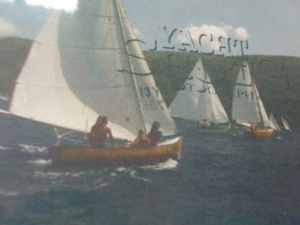
Unfortunately i was too broke at the time to be able to afford to buy the many beautiful pictures taken, so these screen grabs will have to make do.
Then we went to Jost Van Dyke, where i had wooed my wife years before. I had gotten her to crew for me on the 5.2 meter (17′) “Buenadaga”, a mini nativo i used to have, and with which i won the Foxy’s wooden boat race in its class.
The first time we sailed out of Culebra, she promptly vomited the papayas we had shared for breakfast, but laughed and cheerfully carried on with the tasks i had assigned her, which i found endearing. Then, in the races, she was petrified of fully committing to the trapeze, but after a while got more confident. I liked the way she was willing to get over her fears.
On another occasion, on another boat, i sailed aground on a shoal in White bay due to staring at her fantastic legs instead of paying attention to where we were going. No harm done, but one wonders whether this is the kind of thing that prompted the superstition of women being bad luck on board.
Eventually, after nearly three years of flirting, and when we finally were both single i sailed to Jost where she had set herself up, with the intent of taking her back to Puerto Rico with me. The weather turned awful and did not let up for a full three weeks (a particularly vicious stretch of the famous ‘christmas winds’ when the trades blow mercilessly) and as the Buenadaga is a heavily ballasted partly open boat, i was not going to chance the open waters separating the Virgins from Puerto Rico like that. So that is when we really did get together, with the hostage-taker ending up a hostage, sharing a tent on the beach. Those were happy days. When finally we did leave i took the precaution of nailing a piece of discarded plywood from a building site over the aperture in the deck, leaving just enough space to reach down and bail, which was wise, as despite the wind having moderated slightly we got solid water breaking right over the transom and over the entire boat on several occasions.
–*–
While in Jost i again made use of the Oasis as a floating workshop doing some odds and ends on other boats as well as making two boat shaped trophy display shelves for Foxy, in between getting more necessary projects done on the Oasis.
I still had to haul the Oasis out, as it was long overdue but the most economical haul out option in Tortola was closed temporarily so i decided to do it in St Martin instead, planning on making this the last stop on our way to Brasil, since it gives a advantageous angle to get down to Brasil in one long board with a bit of luck.
Apologies for the late post. I normally attempt to publish on thursdays, but was counting on posting another video montage. However, i’m having technical issues with the video renderer, obliging me to write after all at the last moment.
—-*—-
The next few months at Guayama i spent changing the rig and making the boat livable.
A lot of the nativos don’t have floorboards; you just walk on the ballast itself, but the Oasis had floorboards fitted some years after being launched to make tacking faster. This is because when you tack the rail meat all leap down into the hole along with their sandbags and then climb out on the new windward side, but it is a long way up. You have to first heave the sandbag onto the deck and then climb out yourself, and this is easier if the hole is not so deep.
So i removed the floorboards and cut them such that they would fit just over the top of the ballast, for more living space, lowering it by 30 cM. Forward and aft there were no floorboards so i made them. The aft floorboards would become our bunk.
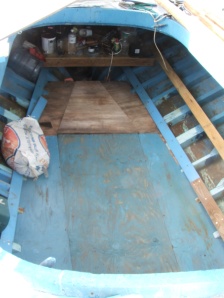
The blue floorboards are the original floorboards, recut to fit lower down and further forward. The paint on the hull shows where the floorboards used to be.
The Oasis is the only Puertorican Nativo which has the mast going through the deck , in front of the opening in the deck. All the others have the partners inside the hole, usually with a strap going across the aft side of the mast. This makes stepping the mast a lot easier, but would have forced me to rebuild the deck aft of the mast before being able to build up a cabin. The reason for this is that it is not good engineering to have the mast go through the cabin top, as it is much weaker than going through the deck which is an uninterrupted span across the boat.
As it was all i had to do was build up the cabin sides around the existing deck aperture and screw and glue to the existing coamings.
After this i was keen to not have beams eating into the little height i had so i made the rooftop out of three layers of 6 mM plywood glued and screwed together over three forms which i subsequently removed. These defined a variable crown rooftop increasing towards the stern significantly.
Using this constuction method enabled me to build a rooftop with no beams at all and quite strong enough. Some may wonder why i didn’t just make the cabintop higher; the reason is because raising the boom makes you lose the most valuable part of the sail, the part that is low down, contributing lift with very little heeling moment. As is, i only raised the boom 25 cM at the gooseneck, although much more at the after end so the boom would not hit the water so easily.
As soon as the cabin was made the boat became an oven, so i quickly made two hatches to re establish the proper ventilation. I also painted over the grey deck paint which would get so hot as to be painful on the feet, with pure white. For boats in the tropics, there is really only one acceptable color; white. I know the glare is something awful, but it is unavoidable, as that is exactly the desired effect; reflect the incident sunlight back away, to keep the boat tolerably cool. The equation is very simple; the less glare, the more heat, and vice-versa and there is really no way around it. Just good sunglasses.
For unstepping the mast i used the mast of a sailboat that was sunk on the other side of the bay, heeled over at a sharp angle. I climbed up this mast, which was quite terrifying i must admit, and set up my block and tackle. Then by anchoring the Oasis with four anchors under the top of this makeshift crane i could pull my mast straight up and out of its hole. Unfortunately, the mast was stuck fast so hard that no amount of force would budge it. So i cut the mast near the heel and dealt with the heel later.
Of course all the hardware, being stainless steel in aluminium was welded tight. Very few screws came out intact, instead i broke them off, and some had to just be ground down. After leaving the mast as a bare pole, i cut 2.5 M off each end, leaving me the fattest part of the mast at the height of the partners. Oddly enough the fattest part had been a couple meters above deck.
For the ends i laminated up wooden plugs, carefully sculpted for a perfect fit. At the heel, a tenon sticks out that fits into a slot on the mast step. The top of this is sloped and liberally sealed with epoxy. A small hole allows any water to drain out of the mast. At the top the plug projects beyond the aluminium so i could shape the step that take the peak halyard and a sheave for the topsail halyard. Both of these were then glued and screwed in place.
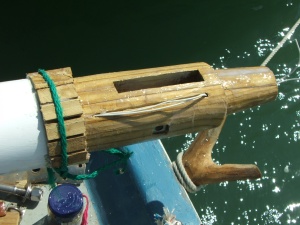
The first step will take the peak halyard. The sheave slot will be for the topsail halyard. The topmost step is for the spinnaker halyard.
In all i removed almost 60 kg of weight from the top of the rig. Selling the aluminium and stainless paid for the few bits of new hardware i needed, namely the new norseman compression cones. The gaff added less than 12 kg to the top of the rig. So i think that demonstrates the fallacy of gaff rigs being top heavy! And it is not true to say that that is due to actually having cut down on sail area, because with the topsail, the boat has almost the same sail area as originally and the topsail yard will only add another 10 kg or so, and that is weight that is there only when needed, and that in light wind.
I think this last point is extremely important to understand; marconi rigs reef only the fabric. All the spars are fixed. On a gaff rig the topsail yard is taken down when not in use, and the gaff itself gets succesively lower with each reef leaving a bare minimum of weight and windage up when the going gets tough.
Another change was i eliminated the two internal halyards, routing everything outside of the mast and taking care to seal the mast up entirely. Although this adds a bit of windage it is not much in terms of total percentage and it makes for one less thing that can go wrong. Also it makes the boat almost uncapsizable; i did some righting moment estimates and with that kind of buoyant volume as soon as they go underwater the boat’s righting moment almost doubles, which is a great safety advantage, especially if you think about how unlikely it would be for a capsized boat to right itself with a hollow mast that is all flooded full of water..
Then i recut the sails using a favorite time saver; contact cement. To save effort i recycled all the corner pieces by cutting them out whole and transposing them to their new positions.
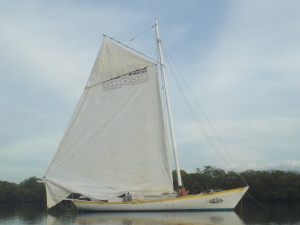
Raising the sail folded along the cut lines and viewing from afar allowed to double check that the measurements i had determined on the drawing board would indeed be correct.
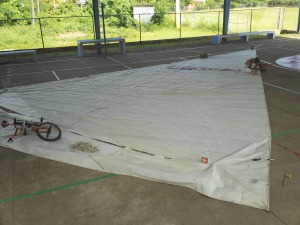
A covered basketball court made an ideal place to work on the sails. All edges and corners were preserved and re-attached in their new positions saving an immense amount of work and money.
The boom also got cut by 2.5 M down from the original 11.3 m to 8.8 M. I also modified the gooseneck to allow the boom to be raised to an angle of around 60 degrees so that it could be used as a crane. This rounded out the boat well for earning money later as a “floating workshop” complete with generator, a large collection of woodworking tools and two cranes (the gaff and the boom) to move heavy objects or step-unstep masts. Not having a cockpit means that the entire stern of the boat is flat and uncluttered for working easily.
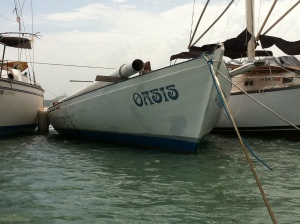
Oasis with mast down.
on one side a boat i was doing work on, on the other a boat i was lookin after and where we also temporarily lived.
Inside i made a galley that uses the entire beam of the boat under the companionway hatch (to vent out the heat and also so i would get standing headroom when cooking) with gymbaled stove and an adjustable angle cutting board. On a cruising boat the galley is the most important area to get right. Cooking at sea is always challenging so every effort should be made to ensure that the galley makes those daily hours as easy as possible.
Forward of this and up to the mast is the cargo area on either side all the way up to the deckhead, leaving a passage in the middle. This gives a good distribution of weight out of the ends of the boat.
The advantage with this sort of boat is that the modifications can be made rough and ready and it doesn’t clash with what is already there. if this were a fancy yacht with delicate wood trim etc, to keep the modifications on the level would require considerably more time and effort.

